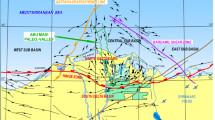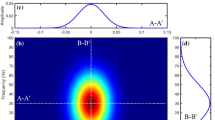Abstract
In geophysical studies, attributes are the main tools for hydrocarbon identification and can be applied either pre- or post-stack. The amplitude versus offset (AVO), on the other hand, lies within the inversion methods applicable to pre-stack seismic data specifically tailored to recognize fluid content. A recent method useful for detecting hydrocarbon-bearing intervals in a reservoir is the spectral decomposition and is applied on post-stack data. For any frequency in a time–frequency setting, a single-frequency seismic section can be drawn and the low-frequency shadows related to the hydrocarbon accumulation can be differentiated. In this study, the spectral decomposition and the AVO analysis methods are applied on synthetic and real data, the latter being an example from a gaseous sandstone reservoir. The synthetic data based on the nearby well-logs and the fluid substituted synthetic well-logs were constructed. Results indicate the superiority of spectral decomposition method in detecting gas-bearing intervals (gas saturation above 80 %) in comparison to the AVO method. While the AVO method successfully differentiates the hydrocarbon and water-bearing intervals, its sensitivity in detecting an interval of 80 and 35 % gas is indifferent. We empirically know that the dominant frequency for detecting shadows of low-frequency features is between 10 and 20 Hz. In this study, such shadows are only observed below high gas saturation intervals by which the economical gas-bearing zones could be discriminated from the non-economic ones.






Similar content being viewed by others
References
Al-Ibrahim M, (2015) Attribute Studio’s spectral decomposition methods comparison, www.geomodeling.ca
Castagna JP, Smith SW (1994) Comparison of AVO indicators: a modeling study. Geophysics 59:1849–1855
Castagna JP, Swan HW (1997) Principles of AVO crossplotting. Lead Edge 16(4):337–342
Castagna JP, Batzle ML, Eastwood RL (1985) Relationship between compressional- and shear-wave velocities in clastic silicate rocks. Geophysics 50:571–581
Castagna JP, Sun S, Siegfried RW (2003) Instantaneous spectral analysis: detection of low-frequency shadows associated with hydrocarbons. Lead Edge 22:120–127
Dehghani MJ (2009) Comparison of S-transform and Wavelet Transform in Power Quality Analysis. World Acad Sci Eng Technol 26:395–398
Deng X, Ma H, Li Y, Zeng Q (2015) Seismic random noise attenuation based on adaptive time–frequency peak filtering. J Appl Geophys 113:31–37
Fatti JL, Smith GC, Vail PJ, Levitt PR (1994) Detection of gas in sandstone reservoirs using AVO analysis: a 3-D seismic case history using the Geostack technique. Geophysics 59:362–1376
Fernandes, F., 2002, Directional, shift-insensitive, complex wavelet transforms with controllable redundancy, Thesis, Rice University
Hampson D, Schuelke J, Quirein J (2001) Use of multi-attribute transforms to predict log properties from seismic data. Geophysics 66(1):220–236
Leite F, Montagne R, Corso G, Vasconcelos G, Lucena L (2008) Optimal wavelet filter for suppression of coherent noise with an application to seismic data. Physica A 387(7):1439–1445
Lin H, Li Y, Yang B, Ma H (2013) Random denoising and signal nonlinearity approach by time-frequency peak filtering using weighted frequency reassignment. Geophysics 78(6):229–237
Loizou N, Liu E, Chapman M (2008) AVO analyses and spectral decomposition of seismic data from four wells west of Shetland, U.K. Pet GeoSci 14(4):355–368
Ostrander WJ (1984) Plane-wave reflection coefficients for gas sands at non-normal angles of incident. Geophysics 49:1637–1648
Pinnegar CR, Mansinha L (2003) The S-transform with windows of arbitrary and varying shape. Geophysics 68(1):381–385
Rutherford SR, Williams Robert H (1989) Amplitude-versus-offset variations in gas sands. Geophysics 54(6):680–688
Shuey RT (1985) A simplification of the Zoeppritz equations. Geophysics 50(4):609–614
Sinha S, Routh PS, Anno PD, Castagna JP (2005) Spectral decomposition of seismic data with continuous-wavelet transform. Geophysics 70:19–25
Smith GC, Gidlow PM (1987) Weighted stacking for rock property estimation and detection of gas. Geophys Prospect 35:993–1014
Stockwell RG, Mansinha L, Lowe RP (1996) Localization of the complex spectrum: the S transform. IEE Paper 44:998–1001
Verm R, Hilterman F (1995) Lithology color-coded seismic sections: the calibration of AVO crossplotting to rock properties. Lead Edge 14(8):847–853
Zhenhua X, Xiaojun X, Bian L (2008) Numerical simulation of seismic low-frequency shadows and its applicatio. Appl Geophys 1.5(4):301–306
Zoeppritz K (1919) Erdbebenwellen VIII B, Über reflexion ad Durchgang seismischer wellen durch Unstetigkeitsflachen: Göttinger Nach, 66–84
Acknowledgments
The authors acknowledge the Institute of Geophysics and research council at University of Tehran for supporting this research.
Author information
Authors and Affiliations
Corresponding author
Electronic supplementary material
Below is the link to the electronic supplementary material.
Rights and permissions
About this article
Cite this article
Nazari, A., Riahi, M.A. & Heidari, B. Detection of gas-bearing intervals using S-transform and AVO analysis. Carbonates Evaporites 32, 53–61 (2017). https://doi.org/10.1007/s13146-015-0277-y
Accepted:
Published:
Issue Date:
DOI: https://doi.org/10.1007/s13146-015-0277-y




